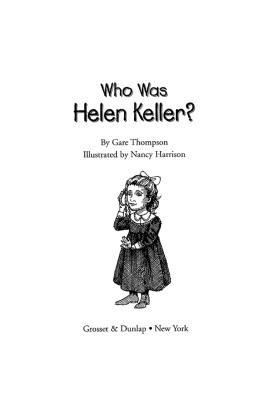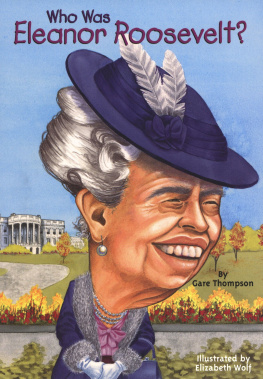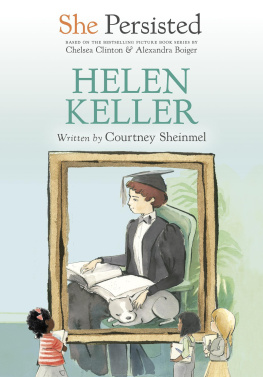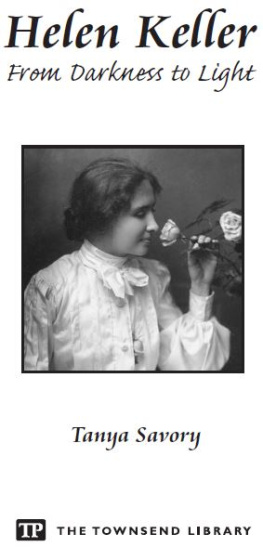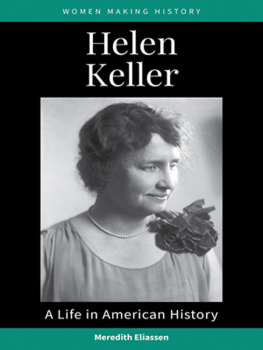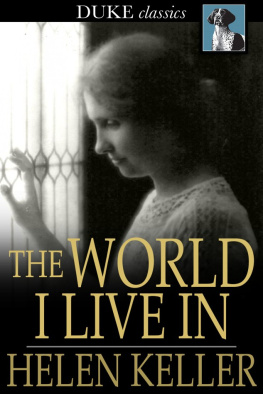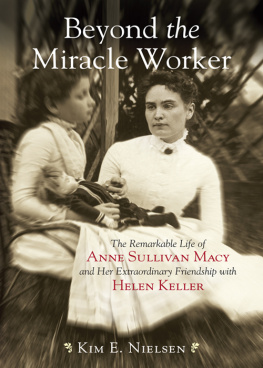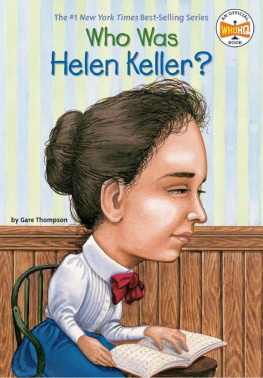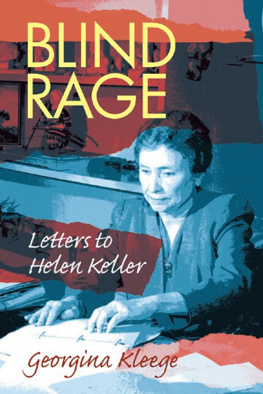Who Was
Helen Keller?
By Gare Thompson
Illustrated by Nancy Harrison
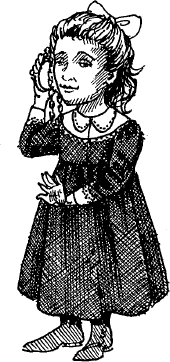
Grosset & Dunlap New York
To my mother, Irene PineG.T.
Text copyright 2003 by Gare Thompson. Illustrations copyright 2003 by Nancy Harrison. All rights reserved. Published by Grosset & Dunlap, a division of Penguin Young Readers Group, 345 Hudson Street, New York, NY 10014. GROSSET & DUNLAP is a trademark of Penguin Group (USA) Inc. Published simultaneously in Canada. Printed in the U.S.A.
Library of Congress Cataloging-in-Publication Data
Thompson, Gare.
Who was Helen Keller? / by Gare Thompson; illustrated by Nancy Harrison.
p. cm.
Summary: A biography of the woman who, with the assistance of her devoted teacher Annie Sullivan, achieved success and fame despite being blind and deaf.
1. Keller, Helen, 18801968Juvenile literature. 2. Blind-deaf womenUnited StatesBiographyJuvenile literature. 3. Blind-deaf womenUnited StatesEducationJuvenile literature. [1. Keller, Helen, 18801968. 2. Blind. 3. Deaf. 4. Sullivan, Annie, 18661936. 5. People with disabilities. 6. WomenBiography.] I. Title.
HV1624.K4T48 2003
362.41092dc22
2003017972
ISBN: 978-1-101-64000-5 30 29 28 27 26 25 24 23
Who Was
Helen Keller?
Born more than 100 years ago, Helen learned to speak and read and write. Those may not sound like great accomplishments. But Helen Keller was both deaf and blind.
Imagine that your ears are stuffed with cotton. You cant hear anythingnot even someone shouting. A blindfold covers your eyes. You cant see anything, either. Your world is dark and silent. This was Helen Kellers world.

When Helen grew up, few deaf people learned how to speak. There were very few schools for deaf and blind children. Few blind people learned how to read and write. Helen Keller not only did both, but also did much more. She wrote several best-selling books. And she gave lectures around the world. She showed that her handicaps had not held her back. Above all, she gave hope to other people who, like her, could not hear or see.

Chapter 1
The Early Years
Helen Keller was born on June 27, 1880, in Tuscumbia, Alabama. Her father, Arthur Keller, had fought in the Civil War for the South. After the war, he went home to his farm. After his first wife died, he married a woman named Kate Adams. His two sons from his first marriage and his young wife called Arthur Keller Captain. In addition to running his farm, Captain was also the editor of the local paper. He was a quiet, stern man.

The first girl in the family, baby Helen lit up a room. She laughed and cooed. Helen was the apple of her mothers eye. Her father adored her. Helen wrote about her early life. She said, The beginning of my life was simple and much like every other little life I came, I saw, I conquered, as the first baby in the family always does.

Helen was smart. She spoke early. Her first words were said to be tea, tea, tea and wah-wah for water. If she did not know the words for things, Helen made up signals to show her mother what she wanted. She learned to walk at an early age. Soon Helen was racing around the house.

Then before she was two years old, Helen became sick. Very sick. She ran a very high fever. At that time, there were few medicines to cure sickness. The doctor thought that Helen would die. Then, suddenly, the fever broke. Helen slept peacefully. Her family rejoiced. Their golden daughter was fine again.

But Helen wasnt fine. While Helens mother was bathing her, she moved her hand in front of Helens face. Helen did not blink. Helens eyes stared straight ahead. Kate tried again. She hoped that she was wrong. But she wasnt. Helen was blind. And that was not all.
Every evening, a bell was rung to call the family to dinner. Everyone heard the loud, clanging noise. They stopped what they were doing and came to dinner. But Kate noticed that Helen no longer turned her head toward the sound. Kate called to the Captain and his sister Evelyn, who lived with them. They shouted at Helen. They spoke softly. They clapped their hands next to her ears. Helen did not react. Mrs. Kellers fear was true. Her daughter was deaf as well as blind.


Her parents took Helen to a doctor. The doctor checked her, but there was nothing he could do. How, Mrs. Keller wondered, would her smart, beautiful little girl learn to live in her silent, dark world?
Chapter 2
Dark Years
There were no days or nights in Helens world. She could not see the sun rising each morning or the moon with its silver glow at night. She could not hear birds sing or crickets chirp. She lived in silent darkness. Imagine if you could not hear, see, or speak. How would you let people understand you? How would you talk?

Helen was smart. She followed her mother around everywhere. She clung to her skirts. Helen noticed different smells. She felt vibrations as people and things moved around her. Over time, Helen found ways to communicate. She made up signals to tell people what she wanted.

There were not many schools for deaf or blind children when Helen was little. There were none where she lived in Alabama. At schools for the deaf, children learned to make signs with their hands. The signs stood for words.
SIGN LANGUAGE

LONG AGO, A GROUP OF DEAF PEOPLE IN PARIS, FRANCE, DEVELOPED THEIR OWN SIGN LANGUAGE. THEN, IN 1755, A TEACHER WHO COULD HEAR, ABB CHARLES MICHEL DE LEPE, LEARNED THESE SIGNS AND ADDED NEW ONES TO FORM A STANDARD SIGN LANGUAGE OF FRENCH. NOW HEARING AND NON-HEARING PEOPLE COULD COMMUNICATE! MANY OF THE FRENCH SIGNS FROM LONG AGO ARE STILL USED TODAY.
By the time she turned five, Helen had made up over fifty signs of her own. She pulled at her mother or her father. That meant come with me. She shoved them away when she wanted them to go. For bread, Helen acted out cutting a slice and buttering it. To say small, Helen pinched a small bit of the skin of her hand. Helen spread her fingers wide and brought them together to mean large. Helen also had signs for everyone in her family. For Captain, or Father, Helen mimed glasses and for her mother, she pulled her hair into a knot at the back of her head.
Next page
